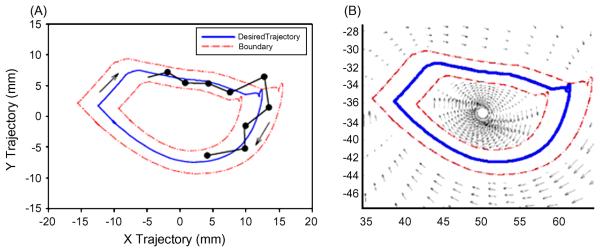Fig. 7.
(A) Schematic of a semi-active fixed-trajectory paradigm for step training, where the desired limb trajectory (blue) is bounded by both inner and outer boundaries (red). The actual trajectory (black) that the neural circuits might induce is allowed to vary within the boundary. However, once the trajectory falls outside of the boundary, the robot will actively bring it back within the boundaries. The black line with periodic dots illustrates the potential positions that the intrinsic neural control might choose to generate for any given bin time. The probability that the neural control would move the limb to the exact position defined by the blue line, representing a fixed trajectory, is highly unlikely. As a result, theoretically, the neural control system is continuously disrupted by the fixed trajectory paradigm. This fixed trajectory, therefore, does not allow the neural control circuitry to respond to any of its intrinsic activation patterns, but rather forces the intrinsic circuitry to continuously respond to external perturbations. This strategy for control would seem to unnecessarily disrupt the spinal circuitry and in the process minimize or even preclude the intrinsic circuitry from interpreting relevant proprioceptive information required to generate a solution (i.e., make choices) and, thus, presumably prevent the circuitry from meaningful learning phenomena. (B) Soft robotic control schematics on how the semi-active control paradigm for step training is implemented. A moving window (red) bounds the desired trajectory (blue) of the mouse limb during stepping. Within the window, the robotic arm allows the mouse to vary its movement. However, when the neural control desired trajectory falls outside of the window, the robot will experience a convergent velocity field, that actively returns the mouse's limbs back within the window. This type of soft control is thought to approximate the “assist as needed” approach used by experienced therapists. (From [4])

